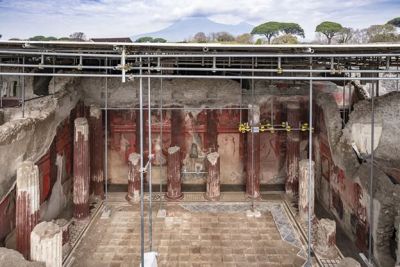More than 100 years after the discovery of the large fresco in the Villa of the Mysteries, a new one has been discovered in the ancient Roman city of Pompeii, in Italy. An almost life-size frieze, or a 'megalography', has emerged which runs around three sides of the room. The cycle of paintings shed light on the mysteries of Bacchus, the Roman version of Dionysus — the ancient Greek god of wine, fertility, theatre and religious ecstasy. Dating to between 40 and 30 BC, according to the scientists, the frescoes feature followers of Bacchus, known as bacchantes, depicted as dancers, hunters carrying a slain goat or sword, and young satyrs with pointed ears playing the flute or performing libations. At the center of the scene is a woman with an old man holding a torch, representing a young mortal participating in a nocturnal ritual to learn the mysteries of Dionysus. All characters are depicted on pedestals. The remarkable discovery, located in insula 10, offers a rare glimpse into how wealthy Romans fused leisure, art, and political ambition within their homes.
Più di 100 anni dopo la scoperta di un affresco nella Villa dei Ministeri, un altro affresco è stato scoperto nell'antica città di Pompei. L'affresco è molto grande e si estende per la lunghezza di tre pareti. L'affresco racconta la storia di Bacco, il dio del vino, della fertilità, del teatro e dell'estasi religiosa. Bacco è lo stesso dio di Dioniso nella mitologia greca. L'affresco risale agli anni 40 e 30 a.C. Le pareti hanno illustrazioni di danzatori, cacciatori con animali macellati, animali che suonano flauti e libagione. Al centro di una parete, c'è una scena di una donna e un vecchio con torce in mano. Tutti i personaggi sono in piedi su piedistalli. Questa scoperta è una meraviglia. Offre uno sguardo sulla ricchezza dei Romani e su come apprezzassero l'arte e la politica nelle loro case.



